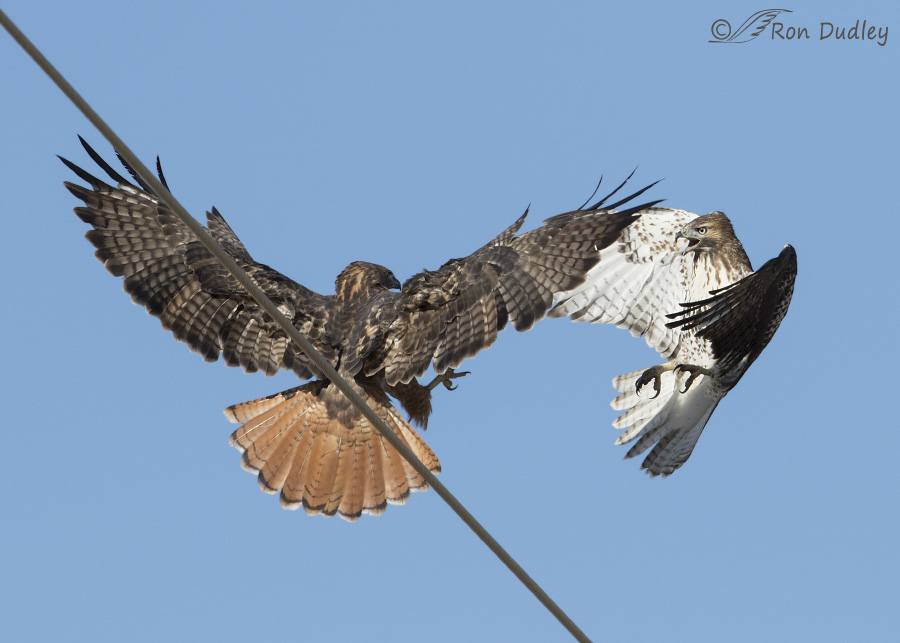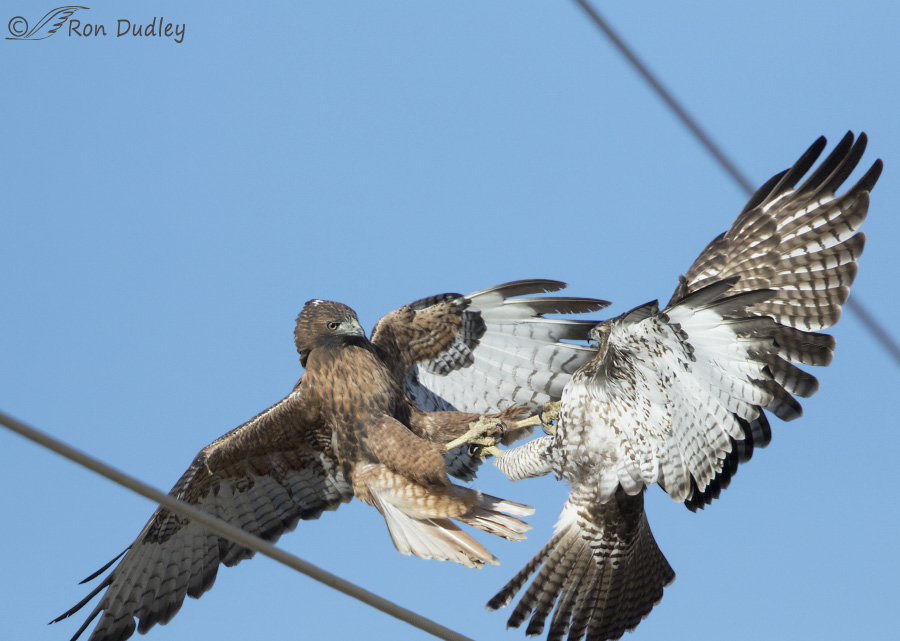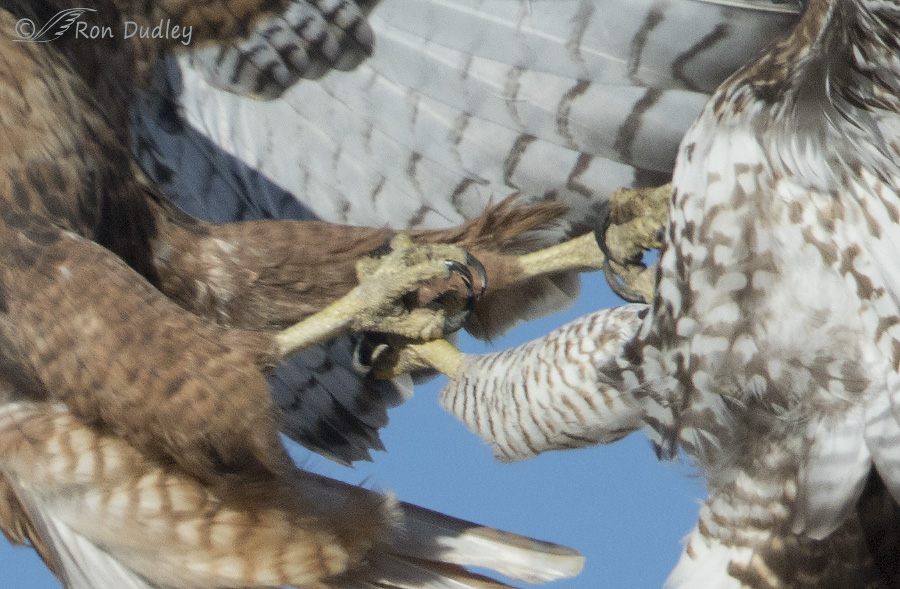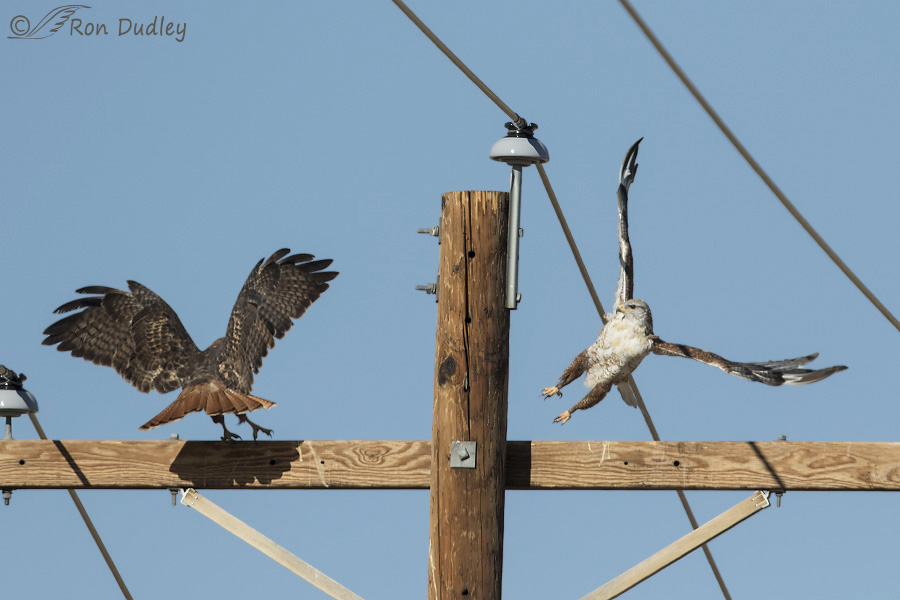Skirmishing raptors are always fun to photograph, even when there are wires in the way.

1/3200, f/7.1, ISO 500, Canon 7D Mark II, Canon EF500mm f/4L IS II USM, not baited, set up or called in
I found these two belligerent Red-tailed Hawks about ten days ago in a remote area of Utah County as they used a line of power poles as launching pads for their attacks on each other. The juvenile on the right seemed almost as aggressive as the adult. I’m not sure how serious these fights were but it seemed to be more than just play. The attacks occurred multiple times as the birds moved down the line of poles.

1/5000, f/6.3, ISO 500, Canon 7D Mark II, Canon EF500mm f/4L IS II USM + 1.4 tc, not baited, set up or called in
Sometimes there was physical contact between them and sometimes there wasn’t but it was maddening because almost every time there were wires between me and the birds. Here the contact between the two hawks is obvious.

A large crop of the previous image shows a slightly more detailed look at that contact. The juvenile on the right has clamped on to the left leg of the adult with both of its feet.
 1/2500, f/7.1, ISO 500, Canon 7D Mark II, Canon EF500mm f/4L IS II USM + 1.4 tc, not baited, set up or called in
1/2500, f/7.1, ISO 500, Canon 7D Mark II, Canon EF500mm f/4L IS II USM + 1.4 tc, not baited, set up or called in
After one of the attacks the adult flew down the line of power poles and very deliberately and aggressively displaced a Ferruginous Hawk (on the right) that was perched on the beam of the pole. The subordinate reaction of the Ferruginous surprised me a little because they’re significantly larger and heavier than Red-tails.
These images were ruined by those darned wires of course but I still thought the behavior was interesting.
Ron


Darned wires indeed. Great shots though.
Eagles grab each others feet and legs when they fight, too. Do you suppose that’s why some tribes called the Red-tail “little eagle”?
Thanks again for the insight Ron! I do use a TC on the 70-200mm, but maybe the light isn’t as good as I think it is Also, I’m still a rookie and always learning–somedays are a joy and some are well…a bit frustrating–I know you understand!
Also, I’m still a rookie and always learning–somedays are a joy and some are well…a bit frustrating–I know you understand!
Spectacular shots ron!!
Charlotte
Thank you, Charlotte.
Wow. What an incredible sight to see. They do seem to be playing rough, don’t they. The Ferruginous Hawk obviously thought discretion was the better part of valour – or alternatively ‘he who runs away, lives to run another day’.
You’re probably right, EC. And I like that pacifist attitude.
Very interesting, as always. We’ve been watching what I have finally realized is a juvenile Red-tailed Hawk out at Hueco Tanks. I finally got a couple of pictures of it up on one of the high rocks, which allowed me to identify it for certain. This is the first time I’d realized that only adults have red tails. I love that you are able to document this behavior, despite the pesky wires, especially the displacement of the Ferruginous Hawk. That bird looked as if it knew it was dangerous to not move out of the way. To me its expression says, ‘my hands are up, I’m out of here, don’t shoot!’.
Yup, that red tail is the easiest way to tell an adult from a juvie, Susan.
Wow, Ron–great rendition of behavior that not many folks get to see or capture I’m perpetually amazed by the quality of your images and the stories they tell–what an inspiration you are! One question–can you tell us how you are able to get such quick SS’s at ISO 500 (or ’round about that ISO) — is it because of the 7DMKII’s upgraded ISO capabilities or… ? I find that even in good light, my trusty 7D needs to be on at least ISO 640 to get anything above 1/1000 (which by now I realize is a threshold hard to go below for me to get a sharp image). I also realize that I’m limited by only having a 70-200mm lens and many subjects are just out of the range of the lens to really get a quality shot. Thanks for any input you would like to provide. I’m considering getting a new camera body in the near future–I might go with a full frame v. crop sensor, so a 5D model is in the running, realizing that the 7DMKII is a winner!
I’m perpetually amazed by the quality of your images and the stories they tell–what an inspiration you are! One question–can you tell us how you are able to get such quick SS’s at ISO 500 (or ’round about that ISO) — is it because of the 7DMKII’s upgraded ISO capabilities or… ? I find that even in good light, my trusty 7D needs to be on at least ISO 640 to get anything above 1/1000 (which by now I realize is a threshold hard to go below for me to get a sharp image). I also realize that I’m limited by only having a 70-200mm lens and many subjects are just out of the range of the lens to really get a quality shot. Thanks for any input you would like to provide. I’m considering getting a new camera body in the near future–I might go with a full frame v. crop sensor, so a 5D model is in the running, realizing that the 7DMKII is a winner!
Christine, the primary reason I’m consistently able to get high shutter speeds with relatively low ISO’s is the speed of my lens. It’s an f/4 lens and that gathers a lot of light which allows for fast shutter speeds.
When most folks see a large lens like mine they think “Wow, you must be able to see the eyelashes of a gnat at a quarter mile with that lens” or something like that. But truth be told, the size (and price) of a lens like mine is as much due to its light gathering capabilities as it is to its magnification.
If you’re after faster shutter speeds I’d definitely consider investing in better (and faster) lenses over newer cameras. In the Canon line that means an “L” lens. Quality lenses aren’t cheap but they’re worth it. With my lens I got fast shutter speeds with the older 7D, the 40D and even the ancient xTI.
A quality lens can last a lifetime (or nearly so) but cameras become obsolete quickly…
Thanks so, so much Ron! Yes, I should have mentioned that a 500mm is on “the list” as well–gotta get that piggy bank filled up first My 70-200mm is super-fast (f/2.8), but it seems that I’m usually limited by reach–that lens is wonderful for certain situations, but capturing wildlife behavior is tough for sure. Thanks again for answering my ISO question — you rock!!
My 70-200mm is super-fast (f/2.8), but it seems that I’m usually limited by reach–that lens is wonderful for certain situations, but capturing wildlife behavior is tough for sure. Thanks again for answering my ISO question — you rock!!
I wasn’t sure how fast your lens was. You’re obviously limited by reach but I’m a little surprised you’re not getting faster SS’s. If you’re consistently shooting at f/2.8 you should be able to get pretty fast shutter speeds in good light but if you’re stopping down (or using a teleconverter) that will slow it down.
But then there’s lots of folks who understand photo-tech stuff better than I do…
These are outstanding, rare you get to witness this let alone get pictures.
Thank you, Steven.
Stunning, wires and all! What must be going through their minds, engaging in such high stakes grappling with wires so nearby…?
I’m sure they’re unaware of the potential dangers of transmission lines, Alison. Kind of makes one wince, though – doesn’t it?
If it was play, it was nasty looking play…the Furruginous hawk must have thought the same thing. Can’t help but wonder if the other juveniles you were watching, the sibling if the one who dropped the vole, the one with the wounded leg may have suffered a similar fate…a grip like the one shown, could injure any part of the leg with the right torque. This is an amazing sequence and detail….
“may have suffered a similar fate”
I suppose that’s very possible with that injured juvenile Swainson’s Hawk, Patty. Interesting thought…
Behavior is very interesting even if the darned wires were in the way. I’m surprised one or both didn’t get electrocuted!
Judy, The power companies around here have been very good about retrofitting power poles to make them less dangerous to raptors, though I’m not sure about the situation with this particular line of poles and wires.